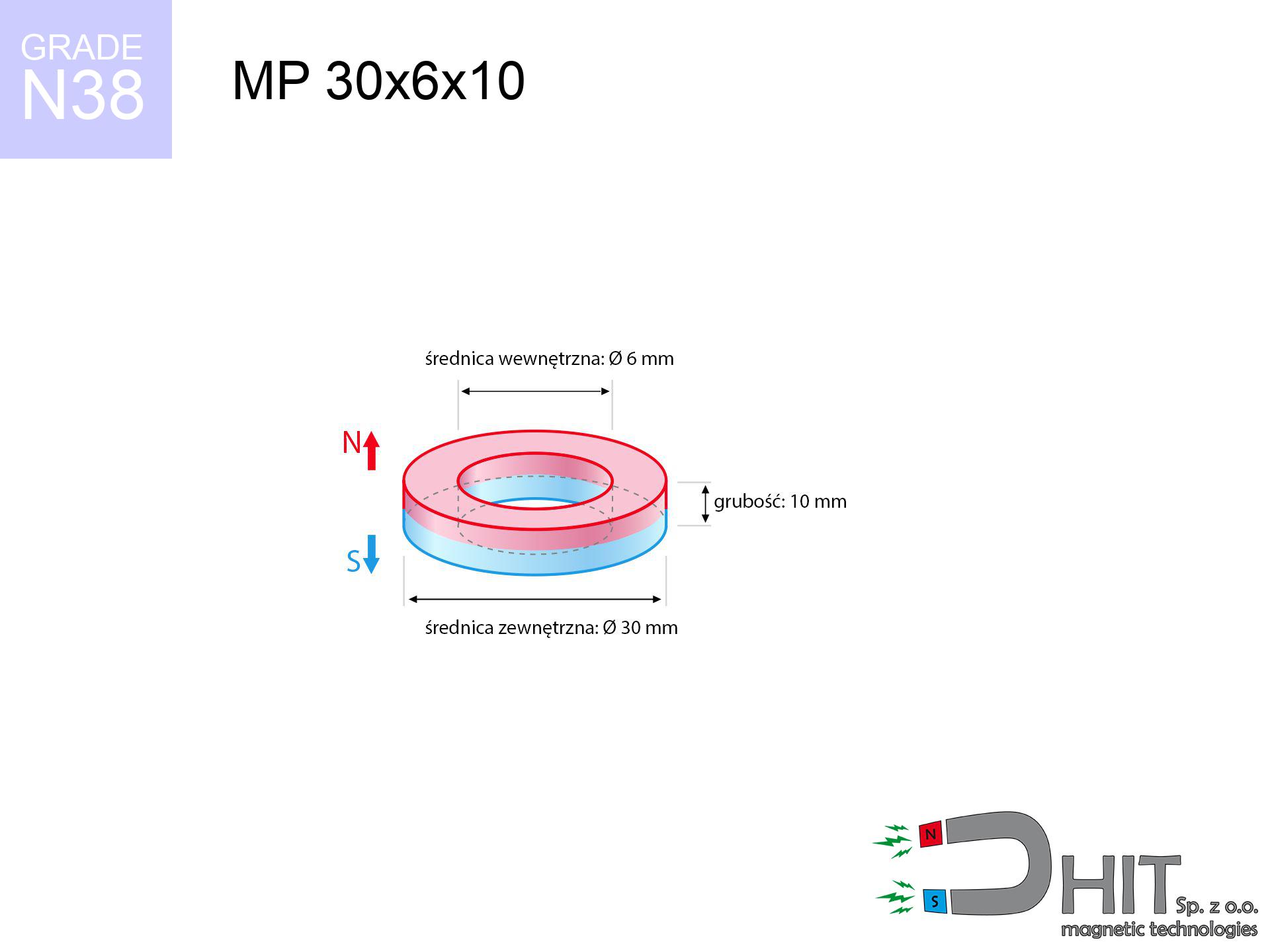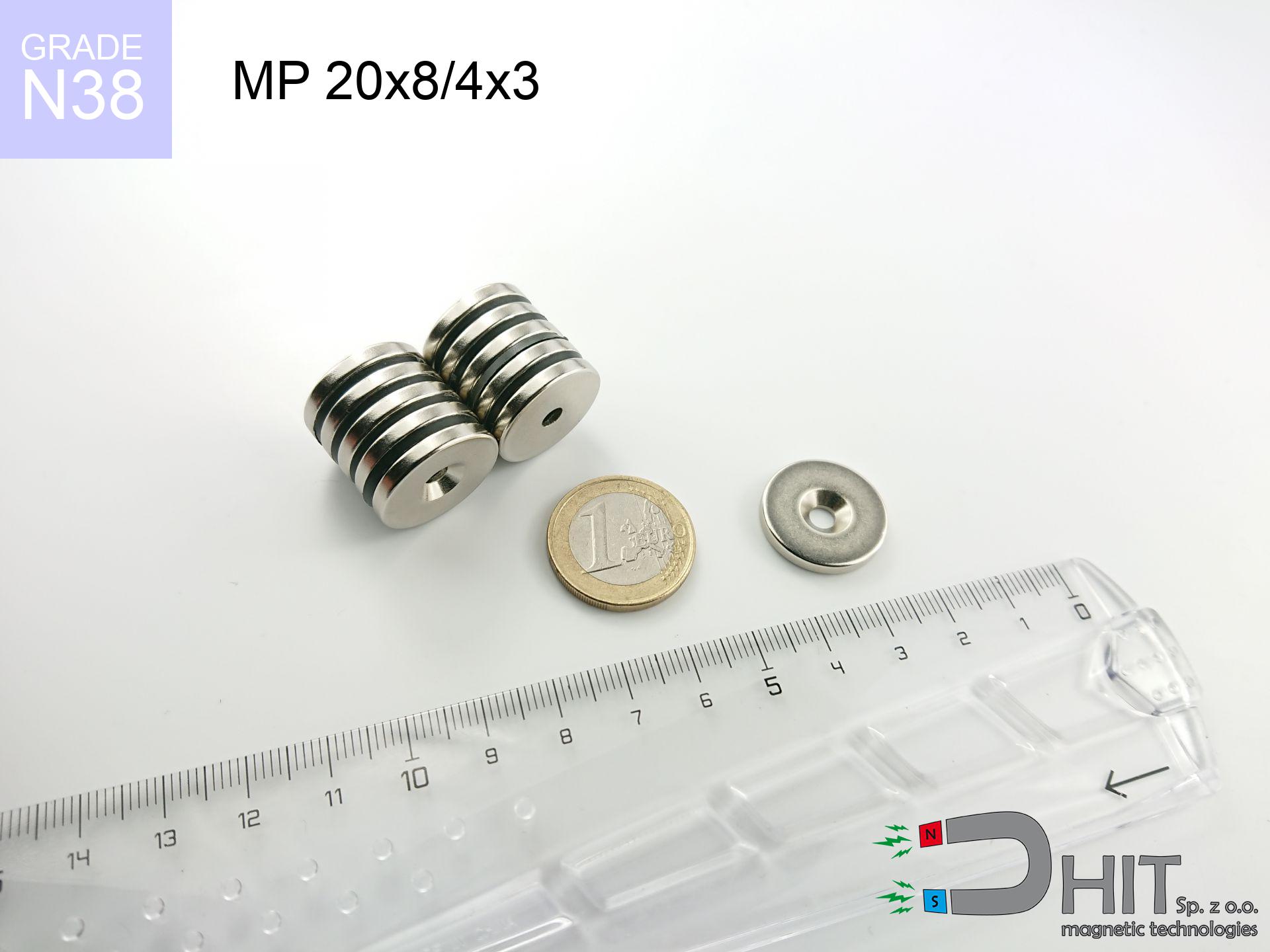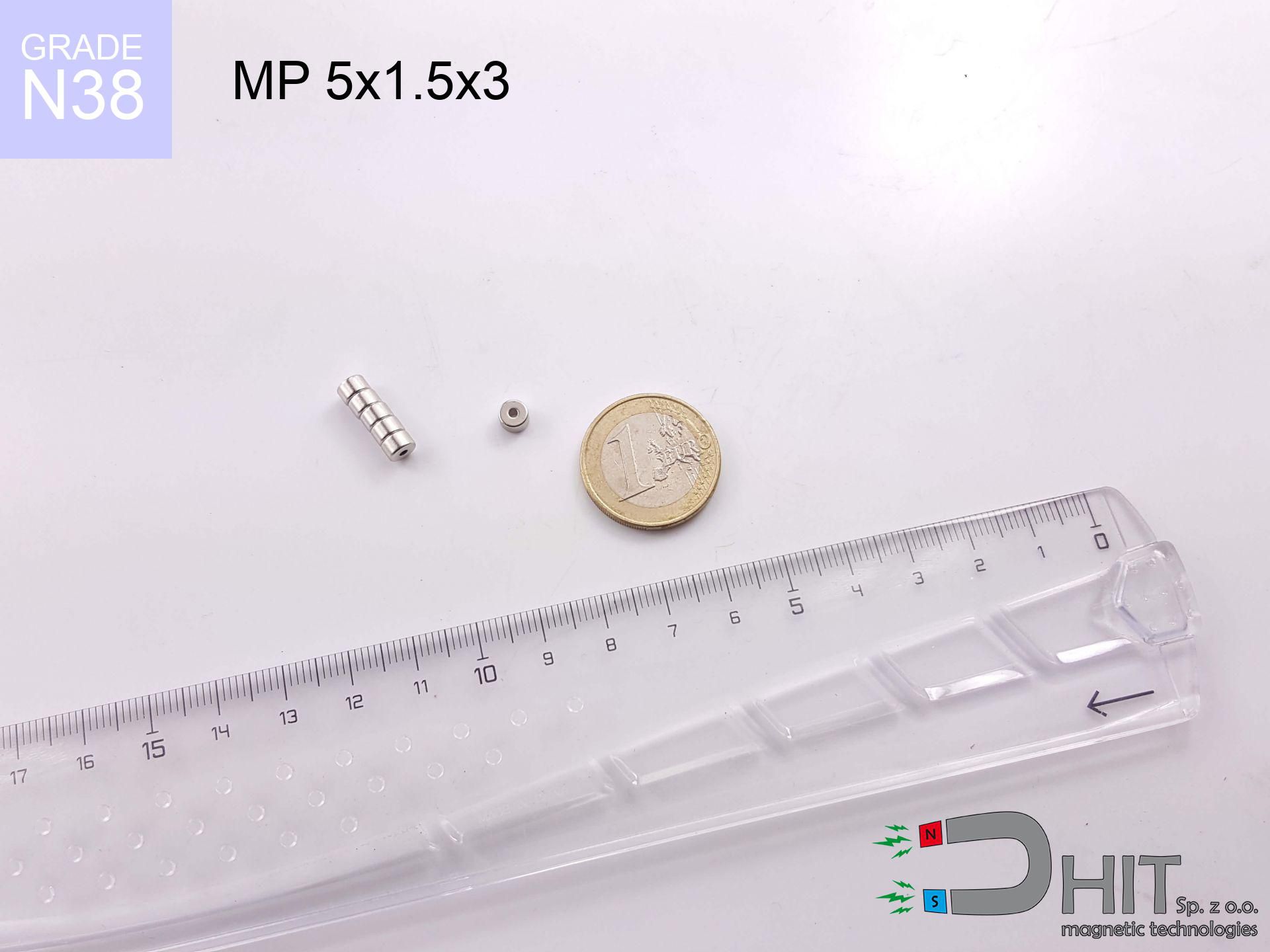MP 30x6x10 / N38 - ring magnet
ring magnet
Catalog no 030197
GTIN/EAN: 5906301812142
Diameter
30 mm [±0,1 mm]
internal diameter Ø
6 mm [±0,1 mm]
Height
10 mm [±0,1 mm]
Weight
50.89 g
Magnetization Direction
↑ axial
Load capacity
20.71 kg / 203.16 N
Magnetic Induction
343.81 mT / 3438 Gs
Coating
[NiCuNi] Nickel
16.00 ZŁ with VAT / pcs + price for transport
13.01 ZŁ net + 23% VAT / pcs
bulk discounts:
Need more?
Give us a call
+48 888 99 98 98
otherwise send us a note through
request form
the contact form page.
Lifting power along with shape of neodymium magnets can be calculated with our
online calculation tool.
Same-day processing for orders placed before 14:00.
Technical details - MP 30x6x10 / N38 - ring magnet
Specification / characteristics - MP 30x6x10 / N38 - ring magnet
| properties | values |
|---|---|
| Cat. no. | 030197 |
| GTIN/EAN | 5906301812142 |
| Production/Distribution | Dhit sp. z o.o. |
| Country of origin | Poland / China / Germany |
| Customs code | 85059029 |
| Diameter | 30 mm [±0,1 mm] |
| internal diameter Ø | 6 mm [±0,1 mm] |
| Height | 10 mm [±0,1 mm] |
| Weight | 50.89 g |
| Magnetization Direction | ↑ axial |
| Load capacity ~ ? | 20.71 kg / 203.16 N |
| Magnetic Induction ~ ? | 343.81 mT / 3438 Gs |
| Coating | [NiCuNi] Nickel |
| Manufacturing Tolerance | ±0.1 mm |
Magnetic properties of material N38
| properties | values | units |
|---|---|---|
| remenance Br [min. - max.] ? | 12.2-12.6 | kGs |
| remenance Br [min. - max.] ? | 1220-1260 | mT |
| coercivity bHc ? | 10.8-11.5 | kOe |
| coercivity bHc ? | 860-915 | kA/m |
| actual internal force iHc | ≥ 12 | kOe |
| actual internal force iHc | ≥ 955 | kA/m |
| energy density [min. - max.] ? | 36-38 | BH max MGOe |
| energy density [min. - max.] ? | 287-303 | BH max KJ/m |
| max. temperature ? | ≤ 80 | °C |
Physical properties of sintered neodymium magnets Nd2Fe14B at 20°C
| properties | values | units |
|---|---|---|
| Vickers hardness | ≥550 | Hv |
| Density | ≥7.4 | g/cm3 |
| Curie Temperature TC | 312 - 380 | °C |
| Curie Temperature TF | 593 - 716 | °F |
| Specific resistance | 150 | μΩ⋅cm |
| Bending strength | 250 | MPa |
| Compressive strength | 1000~1100 | MPa |
| Thermal expansion parallel (∥) to orientation (M) | (3-4) x 10-6 | °C-1 |
| Thermal expansion perpendicular (⊥) to orientation (M) | -(1-3) x 10-6 | °C-1 |
| Young's modulus | 1.7 x 104 | kg/mm² |
Physical simulation of the assembly - technical parameters
These values represent the outcome of a engineering analysis. Values rely on models for the class Nd2Fe14B. Operational conditions might slightly differ. Please consider these calculations as a preliminary roadmap for designers.
Table 1: Static force (force vs distance) - interaction chart
MP 30x6x10 / N38
| Distance (mm) | Induction (Gauss) / mT | Pull Force (kg) | Risk Status |
|---|---|---|---|
| 0 mm |
5619 Gs
561.9 mT
|
20.71 kg / 20710.0 g
203.2 N
|
crushing |
| 1 mm |
5241 Gs
524.1 mT
|
18.01 kg / 18011.7 g
176.7 N
|
crushing |
| 2 mm |
4861 Gs
486.1 mT
|
15.50 kg / 15498.1 g
152.0 N
|
crushing |
| 3 mm |
4490 Gs
449.0 mT
|
13.22 kg / 13223.5 g
129.7 N
|
crushing |
| 5 mm |
3792 Gs
379.2 mT
|
9.43 kg / 9429.0 g
92.5 N
|
strong |
| 10 mm |
2404 Gs
240.4 mT
|
3.79 kg / 3791.3 g
37.2 N
|
strong |
| 15 mm |
1526 Gs
152.6 mT
|
1.53 kg / 1527.0 g
15.0 N
|
weak grip |
| 20 mm |
1000 Gs
100.0 mT
|
0.66 kg / 655.5 g
6.4 N
|
weak grip |
| 30 mm |
482 Gs
48.2 mT
|
0.15 kg / 152.6 g
1.5 N
|
weak grip |
| 50 mm |
161 Gs
16.1 mT
|
0.02 kg / 17.0 g
0.2 N
|
weak grip |
Table 2: Shear capacity (vertical surface)
MP 30x6x10 / N38
| Distance (mm) | Friction coefficient | Pull Force (kg) |
|---|---|---|
| 0 mm | Stal (~0.2) |
4.14 kg / 4142.0 g
40.6 N
|
| 1 mm | Stal (~0.2) |
3.60 kg / 3602.0 g
35.3 N
|
| 2 mm | Stal (~0.2) |
3.10 kg / 3100.0 g
30.4 N
|
| 3 mm | Stal (~0.2) |
2.64 kg / 2644.0 g
25.9 N
|
| 5 mm | Stal (~0.2) |
1.89 kg / 1886.0 g
18.5 N
|
| 10 mm | Stal (~0.2) |
0.76 kg / 758.0 g
7.4 N
|
| 15 mm | Stal (~0.2) |
0.31 kg / 306.0 g
3.0 N
|
| 20 mm | Stal (~0.2) |
0.13 kg / 132.0 g
1.3 N
|
| 30 mm | Stal (~0.2) |
0.03 kg / 30.0 g
0.3 N
|
| 50 mm | Stal (~0.2) |
0.00 kg / 4.0 g
0.0 N
|
Table 3: Wall mounting (sliding) - vertical pull
MP 30x6x10 / N38
| Surface type | Friction coefficient / % Mocy | Max load (kg) |
|---|---|---|
| Raw steel |
µ = 0.3
30% Nominalnej Siły
|
6.21 kg / 6213.0 g
60.9 N
|
| Painted steel (standard) |
µ = 0.2
20% Nominalnej Siły
|
4.14 kg / 4142.0 g
40.6 N
|
| Oily/slippery steel |
µ = 0.1
10% Nominalnej Siły
|
2.07 kg / 2071.0 g
20.3 N
|
| Magnet with anti-slip rubber |
µ = 0.5
50% Nominalnej Siły
|
10.36 kg / 10355.0 g
101.6 N
|
Table 4: Material efficiency (saturation) - power losses
MP 30x6x10 / N38
| Steel thickness (mm) | % power | Real pull force (kg) |
|---|---|---|
| 0.5 mm |
|
1.04 kg / 1035.5 g
10.2 N
|
| 1 mm |
|
2.59 kg / 2588.8 g
25.4 N
|
| 2 mm |
|
5.18 kg / 5177.5 g
50.8 N
|
| 5 mm |
|
12.94 kg / 12943.8 g
127.0 N
|
| 10 mm |
|
20.71 kg / 20710.0 g
203.2 N
|
Table 5: Working in heat (stability) - thermal limit
MP 30x6x10 / N38
| Ambient temp. (°C) | Power loss | Remaining pull | Status |
|---|---|---|---|
| 20 °C | 0.0% |
20.71 kg / 20710.0 g
203.2 N
|
OK |
| 40 °C | -2.2% |
20.25 kg / 20254.4 g
198.7 N
|
OK |
| 60 °C | -4.4% |
19.80 kg / 19798.8 g
194.2 N
|
OK |
| 80 °C | -6.6% |
19.34 kg / 19343.1 g
189.8 N
|
|
| 100 °C | -28.8% |
14.75 kg / 14745.5 g
144.7 N
|
Table 6: Magnet-Magnet interaction (attraction) - field collision
MP 30x6x10 / N38
| Gap (mm) | Attraction (kg) (N-S) | Repulsion (kg) (N-N) |
|---|---|---|
| 0 mm |
103.97 kg / 103971 g
1020.0 N
6 035 Gs
|
N/A |
| 1 mm |
97.15 kg / 97146 g
953.0 N
10 864 Gs
|
87.43 kg / 87431 g
857.7 N
~0 Gs
|
| 2 mm |
90.42 kg / 90424 g
887.1 N
10 481 Gs
|
81.38 kg / 81382 g
798.4 N
~0 Gs
|
| 3 mm |
83.97 kg / 83971 g
823.8 N
10 100 Gs
|
75.57 kg / 75574 g
741.4 N
~0 Gs
|
| 5 mm |
71.94 kg / 71940 g
705.7 N
9 349 Gs
|
64.75 kg / 64746 g
635.2 N
~0 Gs
|
| 10 mm |
47.34 kg / 47337 g
464.4 N
7 583 Gs
|
42.60 kg / 42603 g
417.9 N
~0 Gs
|
| 20 mm |
19.03 kg / 19034 g
186.7 N
4 809 Gs
|
17.13 kg / 17130 g
168.0 N
~0 Gs
|
| 50 mm |
1.53 kg / 1529 g
15.0 N
1 363 Gs
|
1.38 kg / 1376 g
13.5 N
~0 Gs
|
Table 7: Safety (HSE) (electronics) - warnings
MP 30x6x10 / N38
| Object / Device | Limit (Gauss) / mT | Safe distance |
|---|---|---|
| Pacemaker | 5 Gs (0.5 mT) | 19.5 cm |
| Hearing aid | 10 Gs (1.0 mT) | 15.0 cm |
| Timepiece | 20 Gs (2.0 mT) | 12.0 cm |
| Mobile device | 40 Gs (4.0 mT) | 9.0 cm |
| Car key | 50 Gs (5.0 mT) | 8.5 cm |
| Payment card | 400 Gs (40.0 mT) | 3.5 cm |
| HDD hard drive | 600 Gs (60.0 mT) | 3.0 cm |
Table 8: Impact energy (kinetic energy) - warning
MP 30x6x10 / N38
| Start from (mm) | Speed (km/h) | Energy (J) | Predicted outcome |
|---|---|---|---|
| 10 mm |
22.55 km/h
(6.26 m/s)
|
1.00 J | |
| 30 mm |
35.40 km/h
(9.83 m/s)
|
2.46 J | |
| 50 mm |
45.52 km/h
(12.64 m/s)
|
4.07 J | |
| 100 mm |
64.34 km/h
(17.87 m/s)
|
8.13 J |
Table 9: Coating parameters (durability)
MP 30x6x10 / N38
| Technical parameter | Value / Description |
|---|---|
| Coating type | [NiCuNi] Nickel |
| Layer structure | Nickel - Copper - Nickel |
| Layer thickness | 10-20 µm |
| Salt spray test (SST) ? | 24 h |
| Recommended environment | Indoors only (dry) |
Table 10: Electrical data (Flux)
MP 30x6x10 / N38
| Parameter | Value | SI Unit / Description |
|---|---|---|
| Magnetic Flux | 31 585 Mx | 315.8 µWb |
| Pc Coefficient | 0.96 | High (Stable) |
Table 11: Hydrostatics and buoyancy
MP 30x6x10 / N38
| Environment | Effective steel pull | Effect |
|---|---|---|
| Air (land) | 20.71 kg | Standard |
| Water (riverbed) |
23.71 kg
(+3.00 kg Buoyancy gain)
|
+14.5% |
1. Sliding resistance
*Warning: On a vertical surface, the magnet retains just ~20% of its max power.
2. Efficiency vs thickness
*Thin metal sheet (e.g. computer case) drastically weakens the holding force.
3. Heat tolerance
*For standard magnets, the max working temp is 80°C.
4. Demagnetization curve and operating point (B-H)
chart generated for the permeance coefficient Pc (Permeance Coefficient) = 0.96
The chart above illustrates the magnetic characteristics of the material within the second quadrant of the hysteresis loop. The solid red line represents the demagnetization curve (material potential), while the dashed blue line is the load line based on the magnet's geometry. The Pc (Permeance Coefficient), also known as the load line slope, is a dimensionless value that describes the relationship between the magnet's shape and its magnetic stability. The intersection of these two lines (the black dot) is the operating point — it determines the actual magnetic flux density generated by the magnet in this specific configuration. A higher Pc value means the magnet is more 'slender' (tall relative to its area), resulting in a higher operating point and better resistance to irreversible demagnetization caused by external fields or temperature. A value of 0.42 is relatively low (typical for flat magnets), meaning the operating point is closer to the 'knee' of the curve — caution is advised when operating at temperatures near the maximum limit to avoid strength loss.
Elemental analysis
| iron (Fe) | 64% – 68% |
| neodymium (Nd) | 29% – 32% |
| boron (B) | 1.1% – 1.2% |
| dysprosium (Dy) | 0.5% – 2.0% |
| coating (Ni-Cu-Ni) | < 0.05% |
Environmental data
| recyclability (EoL) | 100% |
| recycled raw materials | ~10% (pre-cons) |
| carbon footprint | low / zredukowany |
| waste code (EWC) | 16 02 16 |
Other deals
Strengths as well as weaknesses of neodymium magnets.
Advantages
- Their magnetic field remains stable, and after approximately 10 years it decreases only by ~1% (theoretically),
- Magnets perfectly defend themselves against demagnetization caused by foreign field sources,
- Thanks to the metallic finish, the layer of Ni-Cu-Ni, gold, or silver-plated gives an visually attractive appearance,
- Magnetic induction on the top side of the magnet turns out to be extremely intense,
- Neodymium magnets are characterized by very high magnetic induction on the magnet surface and can function (depending on the form) even at a temperature of 230°C or more...
- Possibility of individual modeling as well as adjusting to atypical conditions,
- Huge importance in future technologies – they are used in hard drives, motor assemblies, precision medical tools, also multitasking production systems.
- Thanks to their power density, small magnets offer high operating force, with minimal size,
Disadvantages
- To avoid cracks under impact, we suggest using special steel holders. Such a solution protects the magnet and simultaneously improves its durability.
- When exposed to high temperature, neodymium magnets suffer a drop in power. Often, when the temperature exceeds 80°C, their strength decreases (depending on the size, as well as shape of the magnet). For those who need magnets for extreme conditions, we offer [AH] versions withstanding up to 230°C
- Magnets exposed to a humid environment can rust. Therefore during using outdoors, we recommend using waterproof magnets made of rubber, plastic or other material resistant to moisture
- Limited ability of producing threads in the magnet and complex forms - recommended is casing - magnetic holder.
- Possible danger to health – tiny shards of magnets are risky, when accidentally swallowed, which gains importance in the context of child health protection. Additionally, tiny parts of these devices are able to be problematic in diagnostics medical when they are in the body.
- High unit price – neodymium magnets have a higher price than other types of magnets (e.g. ferrite), which hinders application in large quantities
Lifting parameters
Best holding force of the magnet in ideal parameters – what contributes to it?
- with the use of a sheet made of special test steel, guaranteeing maximum field concentration
- with a cross-section of at least 10 mm
- with an ideally smooth touching surface
- under conditions of ideal adhesion (surface-to-surface)
- for force applied at a right angle (in the magnet axis)
- at ambient temperature room level
Impact of factors on magnetic holding capacity in practice
- Distance (betwixt the magnet and the metal), because even a tiny clearance (e.g. 0.5 mm) can cause a reduction in lifting capacity by up to 50% (this also applies to varnish, rust or debris).
- Load vector – highest force is reached only during perpendicular pulling. The force required to slide of the magnet along the plate is standardly many times lower (approx. 1/5 of the lifting capacity).
- Base massiveness – insufficiently thick sheet does not close the flux, causing part of the power to be wasted to the other side.
- Material composition – not every steel attracts identically. High carbon content weaken the attraction effect.
- Plate texture – ground elements guarantee perfect abutment, which increases force. Rough surfaces weaken the grip.
- Thermal conditions – NdFeB sinters have a negative temperature coefficient. At higher temperatures they lose power, and at low temperatures they can be stronger (up to a certain limit).
Lifting capacity was determined using a polished steel plate of optimal thickness (min. 20 mm), under vertically applied force, whereas under parallel forces the holding force is lower. Moreover, even a minimal clearance between the magnet’s surface and the plate decreases the lifting capacity.
Safe handling of neodymium magnets
Demagnetization risk
Do not overheat. Neodymium magnets are sensitive to temperature. If you need resistance above 80°C, look for special high-temperature series (H, SH, UH).
Shattering risk
Despite metallic appearance, the material is delicate and cannot withstand shocks. Avoid impacts, as the magnet may shatter into hazardous fragments.
Pinching danger
Mind your fingers. Two large magnets will snap together instantly with a force of several hundred kilograms, crushing anything in their path. Exercise extreme caution!
Electronic hazard
Equipment safety: Neodymium magnets can ruin data carriers and sensitive devices (pacemakers, medical aids, mechanical watches).
Avoid contact if allergic
It is widely known that nickel (the usual finish) is a strong allergen. If your skin reacts to metals, refrain from touching magnets with bare hands and select versions in plastic housing.
Respect the power
Handle magnets with awareness. Their immense force can shock even professionals. Plan your moves and respect their force.
Phone sensors
GPS units and smartphones are extremely sensitive to magnetic fields. Direct contact with a strong magnet can permanently damage the internal compass in your phone.
Pacemakers
Life threat: Strong magnets can deactivate heart devices and defibrillators. Do not approach if you have medical devices.
Machining danger
Drilling and cutting of NdFeB material poses a fire hazard. Neodymium dust oxidizes rapidly with oxygen and is difficult to extinguish.
Product not for children
NdFeB magnets are not suitable for play. Eating multiple magnets can lead to them attracting across intestines, which constitutes a critical condition and necessitates immediate surgery.









